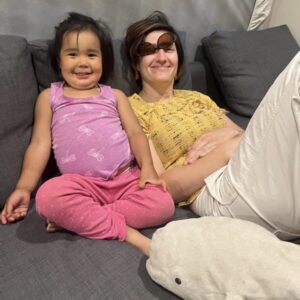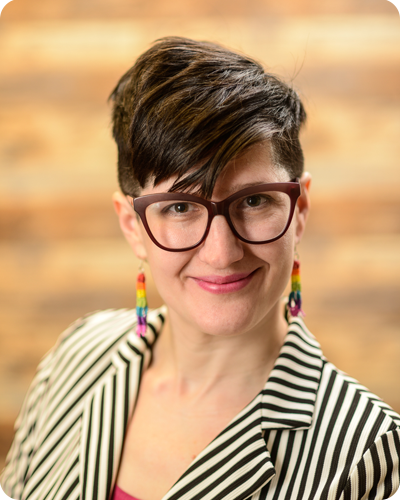Surviving Suicide Loss

Subscribe to Catalyst
Subscribe to get our magazine delivered right to your inbox
Related Articles
Related Articles
Navigating stigma, grief, and loss and finding healing, hope, and community support after a death by suicide. A personal story.
Each November, people around the world take part in special events to mark International Day for People Impacted by Suicide. Those directly affected by suicide loss often use this day to remember loved ones and share their stories and experiences. Here is just one. Names have been changed for privacy reasons.
Rachel died by suicide on June 15, 2022, six weeks after her 30th birthday. I had known her for just over a year. We had been neighbours, then close friends, then briefly lovers. My relationship with her, though affectionate, was fraught with conflict and I have felt immense guilt for my self-perceived role in her death, for not being the partner she needed me to be, for not loving her the way she needed to be loved.
I’m sharing my story because suicide continues to carry an immense stigma, and loved ones who remain can feel isolated in their grief.
As with any tragedy, suicide reaches far beyond the act itself; its ripples are extensive. I think about the many people who have been, and will likely continue to be, affected by Rachel’s death: her best friend, who discovered her in her home two days after she died; her colleagues, who valued her for far more than her productivity and perfectionism; members of her biological and chosen families, who reached out to me on Facebook, searching for answers in the weeks following her death; her transgender teen cousin, who looked up to Rachel as a queer role model and confidante; and her ex-partner, Nigel, with whom she had had a nine-year relationship and who bore the unenviable responsibility of selling the home they co-owned and sorting through all her personal belongings.

Joy and Jessica Ruano.
Honest conversations
When I heard about Rachel’s death, my first thought went to my daughter Joy, who was not quite two and a half years old at the time. Joy had known Rachel for half of her short life, and their beautiful bond included visits to the Canada Agricultural Museum farm and sitting on her lap to play piano together. As a solo parent raising a young child during a worldwide pandemic, I was grateful to have Rachel as one of the few people I trusted to care for Joy.
I believe in being transparent and truthful with children. So I told Joy as soon as she asked that we wouldn’t be seeing Rachel anymore because she had died, that it was very sad, and that we were going to miss her and it was okay to talk about it.
The following week, we visited with several of our former neighbours, many of whom came out to sit with me and Joy in sadness and solidarity. I answered their questions, as many of them were still very much in the dark regarding the circumstances of Rachel’s death. Yet a new awkwardness and a weighty cheerlessness hung over our little cul-de-sac. The previous year, I had hosted Junkyard Symphony, an environmentally conscious percussion group, in the middle of the street. It was one of many events that spoke to the atmosphere and culture: a place where the kids would always come out and play together, where the neighbours didn’t mind if Joy picked and ate the tomatoes right from their front yard, and where we knew all the names of the dogs and the cats (even the tortoise, Miguel) who lived there. Rachel adored this community, which she lovingly referred to as Sesame Street, and her little house she had wanted to live in forever.
After two weeks off, I tried to go back to work. For brief periods, I was able to focus on the tasks at hand; other times, I found myself staring into space. Often, I felt raw, on the brink of crying, or having a panic attack — my emotions volatile. I did what I could, then requested more time off with the support of my family doctor. But knowing where to direct my energy and how to find healing was hard. The people who had been showing up for me in the first few days and weeks were quickly dispersing, moving on with their lives as people do. Then, some of my close friends stopped talking to me. Most made excuses about being busy, even though before Rachel’s death we regularly got together, and one actually sent me an email citing Rachel’s suicide as one of the main reasons she needed to take a “break” from our friendship. This was a hard blow, as my relationship to my immediate family was strained, so I yearned for the support of my chosen family during this time.
Finding support
In mid-August, feeling lost and very much alone in my grief, I reached out to Bereaved Families of Ontario and started attending their Thursday afternoon support group over Zoom. I also attended an LGBTQ2S+ Death Café hosted by the Home Hospice Association on Tuesday evenings, which focused on political questions around death, dying, and illness as they pertain to the queer community; for example, relying on chosen family rather than non-supportive biological family. I started listening to Paula Fontenelle’s Understand Suicide podcast, which recently reached 100 episodes.
These were the voices I needed to hear: people who were willing to push through their discomfort with death and suicide to talk about their feelings openly, whether the loss was last month or several years ago. I found myself thinking outside my own grief to empathize with the man who lost his wife of fifty years to cancer, with the young woman who lost her father in a politically charged murder, with the people who had suffered multiple losses over the years and felt utterly destabilized by the repeated blows. I knew I was not alone in my experience, though it often felt that way, and connecting with other people, even strangers I might never meet outside the virtual world, helped me remember that.
Through all this, I wanted to make sure I was being a consistent parent for Joy. A friend of mine asked me recently how I managed to keep it together over the past year, and my best answer was simply Joy — you don’t have the option to fall apart when your child needs you. At least, I didn’t. I couldn’t.
But it wasn’t easy. Joy frequently brought up Rachel — the places they went together, games they would play, and items in our home — like kitchen utensils or pieces of clothing — that reminded her of Rachel. I always tried to respond positively, even though it sometimes pained me to hear about her. One night, Joy woke up screaming and later expressed between sobs: “I’m sad . . . because Rachel went away.” For many months, she had been sleeping comfortably in her own bed, but after Rachel’s death, she became increasingly resistant to spending nights apart from me. I questioned her about it, and she eventually explained that she was afraid to let me sleep alone without her — because I might die like Rachel did. And the questions continued:
“Why did Rachel die?”
She was sick, my love.
“Was she old?”
No, baby, she was young. Younger than me.
“I don’t want her to be dead.”
Me neither.
“I miss her.”
Me too.
While I couldn’t bring Rachel back or promise that we wouldn’t lose other people in the future, I did my best to reassure her that “Mama and Joy are forever” in case there was any doubt in her mind.
“And Ba, too?” she asked, about her stuffed beluga.
And Ba, too.
More than one year later, I continue to feel the effects of Rachel’s death, including symptoms of post-traumatic stress disorder. The difficulties I’ve been having with concentration and managing anxiety, especially when in front of a computer, mean that I’m unable to work like I used to. So, I recently made the shift from salaried employment to freelance work to allow for more flexibility in my schedule. With regular therapy, I’ve been working through my feelings of guilt and on being the best possible parent for Joy. I’ve been building back my community of support, finding comfort in the people who showed up for me at the most challenging times. I exercise and meditate to maintain a healthy body and tranquil mind. And I write as much as I can.
Earlier this year, perhaps in a reactionary move, I booked flights for us to London, England, where I lived for four years just over a decade ago. For four weeks this past July, we travelled across Europe by train with only a carry-on suitcase and a backpack. It was good to step out of our routine and leave behind all the reminders of last summer. Apart from the usual challenges of travelling with a young child, such as meltdowns stemming from ever-changing environments, it was a wonderful bonding experience for us.
I am so grateful for my life and for wanting every day to be alive and to stay alive, even on the hardest days. I have a fierce desire not only to survive but to thrive in this life. So, with Joy by my side, that is exactly what I will continue to do.
Wellness Together Canada crisis support: If you’re in distress, you can text WELLNESS to 741741 to connect with a mental health professional at any time. If it’s an emergency, call 911 or go to your local emergency department.
Assistance: People in Canada experiencing mental health distress can get assistance through Talk Suicide Canada. Dial toll-free: 1-833-456-4566.
Resources:
- Suicide Prevention (Mental Health Commission of Canada)
- Talking to Children About a Suicide

Jessica Ruano
A queer writer, performer, and educator who has spent the past 20 years collaborating with theatre companies and arts organizations in Ottawa and London. Currently working on her debut memoir—a queer love story—and a second about her journey to adopt as a solo parent, she’s also studying psychology with plans to pursue a Master of Education in counselling psychology. When not writing or studying, Jessica enjoys modelling for artists, which helps her take a break from the computer and support her mental health.